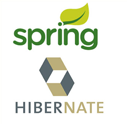
Spring and Hibernate is an in-depth course geared for experienced Java developers who need to understand what Hibernate is in terms of today's systems and architectures, and how to apply Hibernate to persistence requirements in Java and Java EE applications. The course then covers to the Spring framework and how to integrate Hibernate as the persistence layer for Spring applications
The Spring framework is an application framework that provides a lightweight container that supports the creation of simple-to-complex components in a non-invasive fashion. Spring's flexibility and transparency is congruent and supportive of incremental development and testing. The framework's structure supports the layering of functionality such as persistence, transactions, view-oriented frameworks, and enterprise systems and capabilities. Spring's Aspect-Oriented Programming (AOP) framework enables developers to declaratively apply common features and capabilities across data types in a transparent fashion.
Spring makes Java EE development easier. Spring simplifies commons tasks and encourages good design based on programming to interfaces. Spring makes your application easier to configure and reduces the need for many Java EE design patterns. Spring puts the OO design back into your Java EE application
Understand how to use Hibernate within the Spring framework
Drawbacks of direct JDBC
Plain Old Java Object (POJO)
What is O-R Mapping
Simple Database Application
Id and Primary Key
Id Generation Methods
SessionFactory
Session
Transaction
Developing CRUD Application
Creating Criteria
Narrowing the Result
Ordering the Result